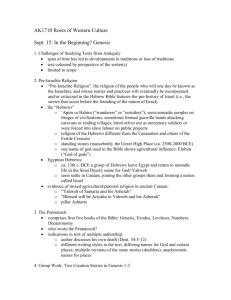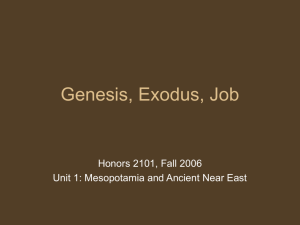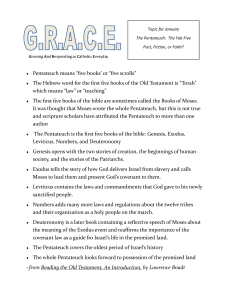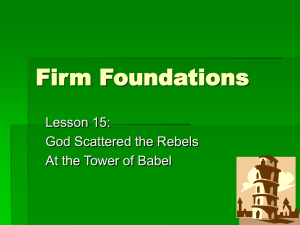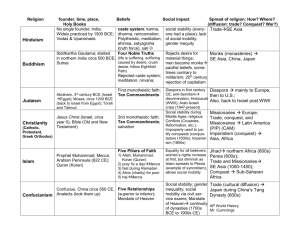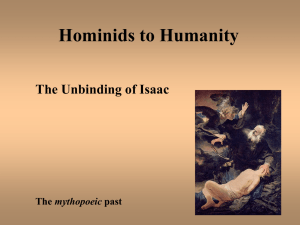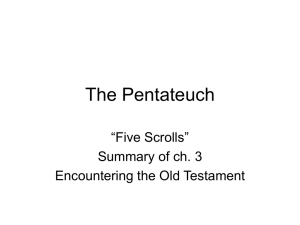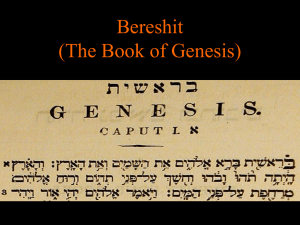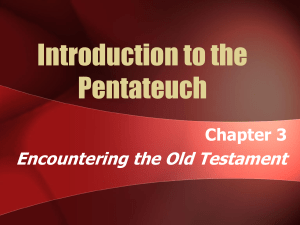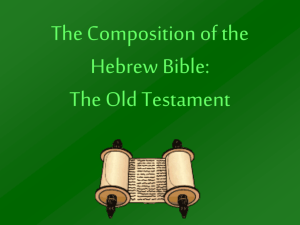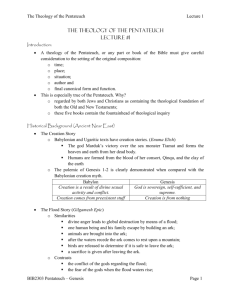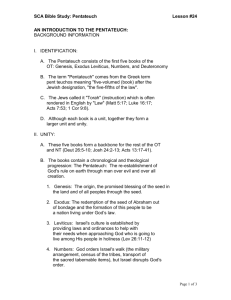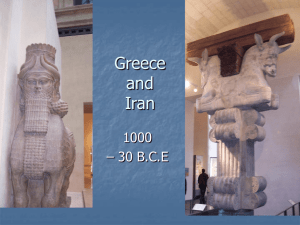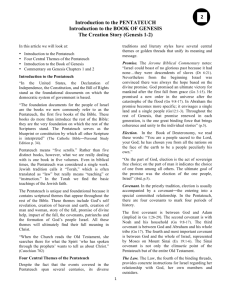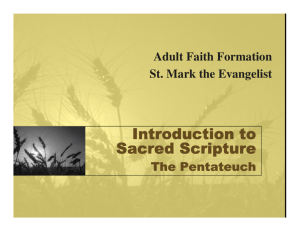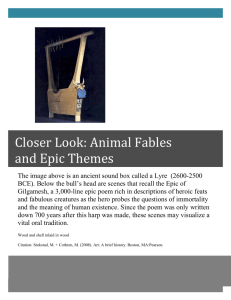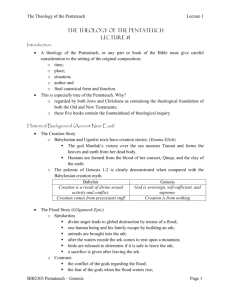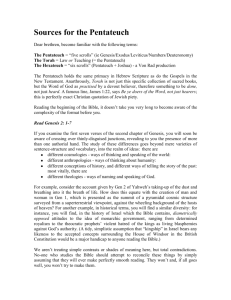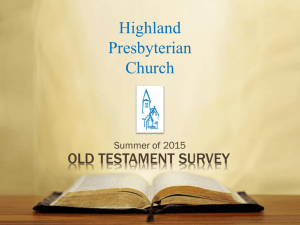lecture outline
advertisement
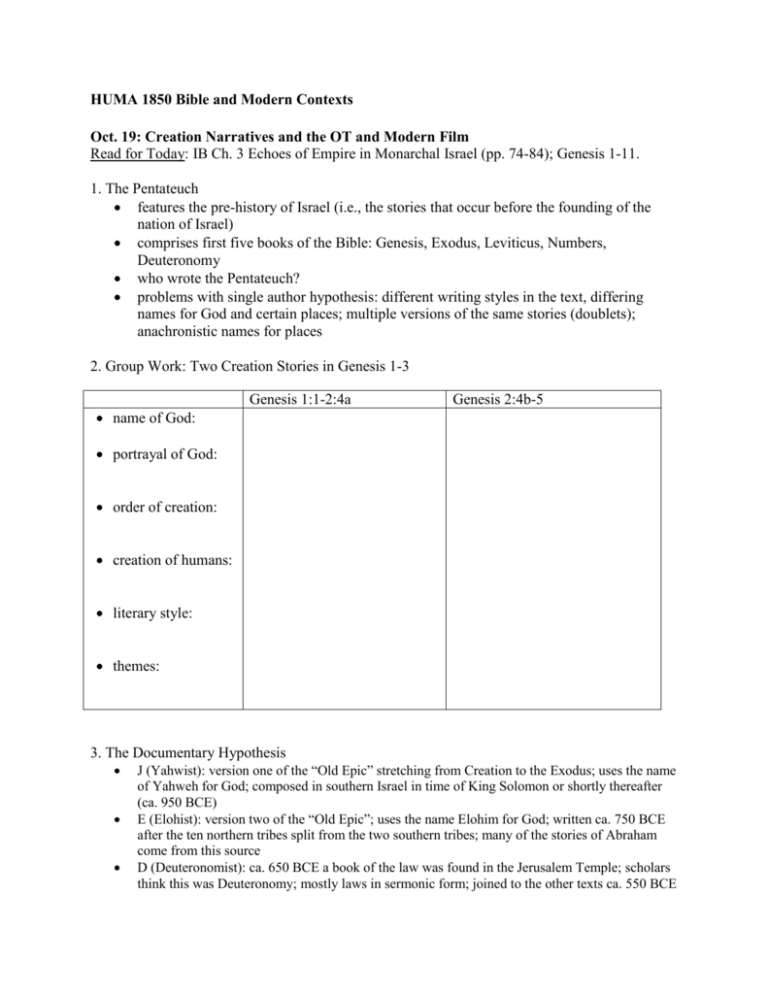
HUMA 1850 Bible and Modern Contexts Oct. 19: Creation Narratives and the OT and Modern Film Read for Today: IB Ch. 3 Echoes of Empire in Monarchal Israel (pp. 74-84); Genesis 1-11. 1. The Pentateuch features the pre-history of Israel (i.e., the stories that occur before the founding of the nation of Israel) comprises first five books of the Bible: Genesis, Exodus, Leviticus, Numbers, Deuteronomy who wrote the Pentateuch? problems with single author hypothesis: different writing styles in the text, differing names for God and certain places; multiple versions of the same stories (doublets); anachronistic names for places 2. Group Work: Two Creation Stories in Genesis 1-3 Genesis 1:1-2:4a Genesis 2:4b-5 name of God: portrayal of God: order of creation: creation of humans: literary style: themes: 3. The Documentary Hypothesis J (Yahwist): version one of the “Old Epic” stretching from Creation to the Exodus; uses the name of Yahweh for God; composed in southern Israel in time of King Solomon or shortly thereafter (ca. 950 BCE) E (Elohist): version two of the “Old Epic”; uses the name Elohim for God; written ca. 750 BCE after the ten northern tribes split from the two southern tribes; many of the stories of Abraham come from this source D (Deuteronomist): ca. 650 BCE a book of the law was found in the Jerusalem Temple; scholars think this was Deuteronomy; mostly laws in sermonic form; joined to the other texts ca. 550 BCE P (Priestly): end of 6th c. BCE Israelites return from Exile in Babylon; there was then an attempt by the priestly class to reinvigorate and restore worship; part of effort was to create a unified history of Israel; these priests gave the Pentateuch its final form ; (ca. 500-400 BCE) and added legal materials related to worship and genealogical lists a new Documentary Hypothesis: L (Lay or “non-priestly” source) instead of J and E the stories of the Pentateuch are united by a single theme: a cycle of rebellion/disobedience, punishment, mercy 4. Gen. 6-9: Noah and the Flood Prelude (6:1-4): The Story of the Sons of God what is the purpose of this story? what have you seen that is similar thematically to previous Genesis stories? the Documentary Hypothesis Case Study 2: the Flood of Noah Near Eastern parallels: Epic of Gilgamesh and Epic of Atrahasis Gilgamesh dates roughly to 3000-2000 BCE: similarities and differences? Yahweh’s covenant with Noah (9:8): “Then God said to Noah and to his sons with him, ‘As for me, I am establishing my covenant with you and your descendants after you and with every living creature that is with you…that never again shall all flesh be cut off by the waters of a flood, and never again shall there be a flood to destroy the earth.’” also leaves humans with dietary rules (9:3): “Every moving thing that lives shall be food for you; and just as I gave you the green plants, I give you everything. Only, you shall not eat flesh with its life, that is, its blood”; referred to as the Noahic laws, become required of non-Jews in Jewish lands 5. Gen 11:1-9: The Tower of Babel the ziggurat of Ur note: plural name for God, use of the disobedience—punishment—mercy theme 6. Psalms Hebrew title is Praises; a hymnbook of praise and thanksgiving addressed to God rather than from God like the prophets 150 psalms divided into five books as reflection of the Pentateuch attributed to David but come from various times and various authors: royal, laments, liturgy borrowings: Ps. 104 and the Egyptian Hymn to Aton; Ps. 29 originally about Baal?; Pss. 14 and 40 virtually identical to 53 and 70
